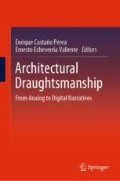Abstract
The format of video game seems revealing to explore a number of architectural phenomena: the architect is nowadays actively enrolled in the construction of interactive digital places as part of extensive multidisciplinary work teams. Originally linked to military experiments and computer labs, video game gender is rather implied on research and academic teaching-learning literature. The number of university programs considering this subject an issue beyond technological gadgets or mere entertainment has exponentially increased. The purpose of this communication is advancing in the emergence of a video games pedagogy promoting its inclusion in architecture university curricula. This paper proposes a topological analysis of the video game with a clear pedagogical intention to structure a hypothetical video game undergraduate course, preferably under the field of knowledge of design ideation and graphics.
References
Aarseth, E. 2001. Computer game studies, Year one. Game Studies 1. Disponible en: http://gamestudies.org/0101/editorial.html (Consultada el 3 de junio de 2014).
Aarseth, E. 2007. Investigación sobre juegos: aproximaciones metodológicas al análisis de juegos. Artnodes no 7, Universitat Oberta de Catalunya. Disponible en: http://artnodes.uoc.edu (Consultada el 20 de julio de 2014).
Bogost, I. 2007. Persuasive games. The expressive power of videogames. Cambridge, MA: MIT Press.
Bolter, J., and R. Grusin. 2000. Remediation. Understanding new media. Cambridge: MIT Press.
Boron, D. 2006. A short story of digital gamespace. In Space time play, eds. Von Borries F., S. Waltz, M. Böttger. Basel: Birkhäuser.
Consalvo, M., and N. Dutton. 2007. Game analysis: development a methodological toolkit for the qualitative study of games. Artnodes, Universitat Oberta de Catalunya. Disponible en: http://artnodes.uoc.edu (Consultada el 20 de junio de 2012).
DRAE: Diccionario de la Real Academia de la Lengua.
López-Galiacho, E. 2014. Habitar lo irreal. Aproximaciones a una arquitectónica de los mundos virtuales. tesis doctoral inédita, Universidad Politécnica de Madrid, ETSAM.
Montagnana, V. 2008. Videojuegos: Una nueva forma de cultura. Su evolución a lo largo de la historia. Barcelona: Ma Non troppo.
Murray, J. 1997. Hamlet on the holodeck: The future of narrative in cyberspace. Cambridge, MA: MIT Press.
Orwell, G. 1949. 1984, UK: Harvill Secker.
Roig, E. 2013. El Entorno Aumentado. Imperativo informacional para una ecología digital de lo arquitectónico. tesis doctoral inédita, Universidad Politécnica de Madrid, ETSAM.
Shannon, R.E. 1975. Systems simulation: the art and science. Englewood Cliffs, N.Y.: Prentice-Hall.
Von Borries, F., S. Waltz, and M. Böttger. 2007. Space time play. Basel: Birkhäuser.
Wachowski Li., and Wachowski La. 1999. The Matrix, USA: Warner Bros.
Video Games
Asteroids, 1979. Developed and published by Atari.
Atari, 1972. Developed by Alcorn, A., published by Atari.
Battlezone, 1980. Developed and published by Atari.
Commando, 1985. Developed and published by Capcon.
Donkey Kong, 1981. Developed and published by Nintendo.
Don Quijote, 1987. Developed and published by Dinamic Software.
Doom, 1993. Developed by ID Software and published by GT Interactive.
Gauntlet, 1985. Developed and published by Atari.
Ghost’n Goblins, 1984. Developed by Capcon and published by Capcon and Taito America.
Kung-Fu Master, 1984. Developed and published by Irem and Nintendo.
Little Computer People, 1985. Developed and published by Activision.
1942, 1984. Developed and published by Capcon.
Pac-Man, 1980. Developed by Namco, published by Namco and Midway.
Paperboy, 1984. Developed by Atari and published by Atari, Elite Systems and Mindscape.
Q*Bert, 1982. Developed and published by Atari.
Quake, 1996. Developed by ID Software and published by GT Interactive.
SimCity, 1989. Developed by Maxis and published by Atari and EA.
Shinobi III, 1993. Developed and published by Sega.
Space Invaders, 1978. Developed by Taito Corporation, published by Midway.
Super Mario Bros, 1985. Developed and published by Nintendo.
The Oregon Train, 1974. Developed by MECC, published by MECC.
Wii Sports, 2006. Developed and published by Nintendo.
Author information
Authors and Affiliations
Corresponding author
Editor information
Editors and Affiliations
Rights and permissions
Copyright information
© 2018 Springer International Publishing AG
About this paper
Cite this paper
Roig, E., Mestre, N. (2018). A New Academic Realm: Video-Game Enrols in College. In: Castaño Perea, E., Echeverria Valiente, E. (eds) Architectural Draughtsmanship. EGA 2016. Springer, Cham. https://doi.org/10.1007/978-3-319-58856-8_12
Download citation
DOI: https://doi.org/10.1007/978-3-319-58856-8_12
Published:
Publisher Name: Springer, Cham
Print ISBN: 978-3-319-58855-1
Online ISBN: 978-3-319-58856-8
eBook Packages: EngineeringEngineering (R0)

